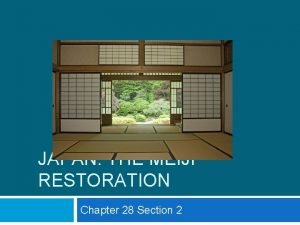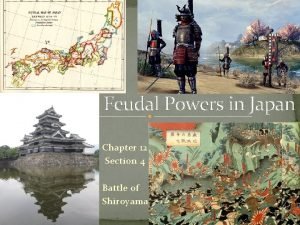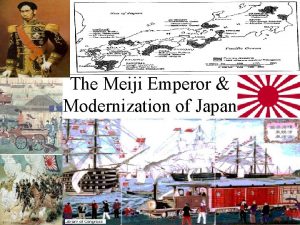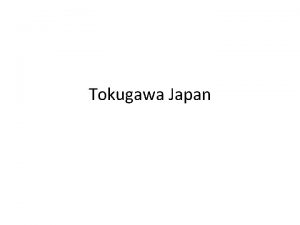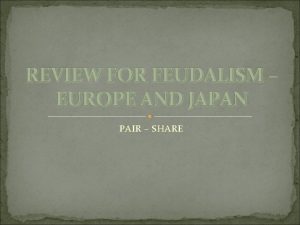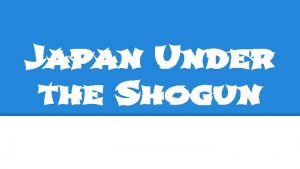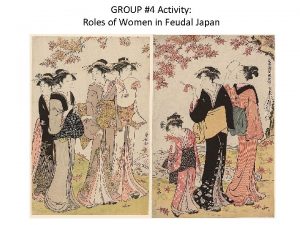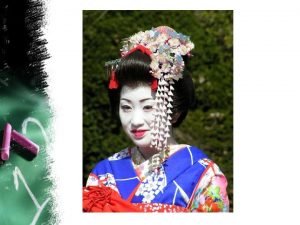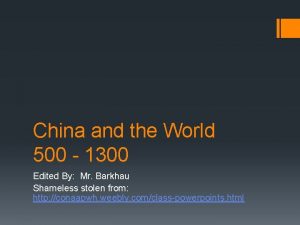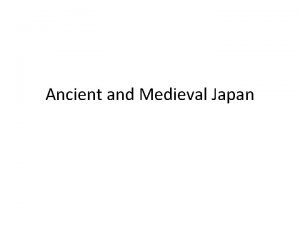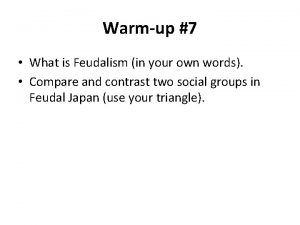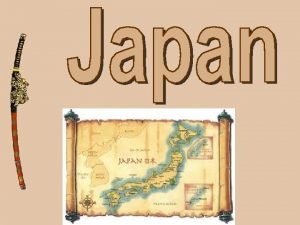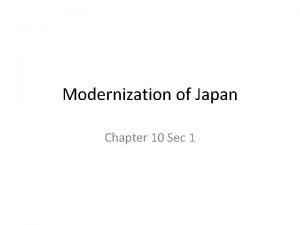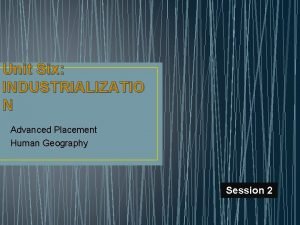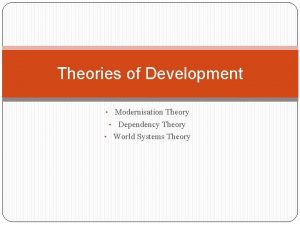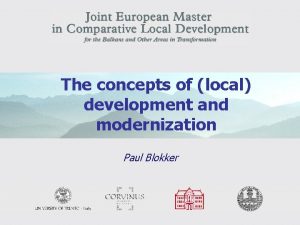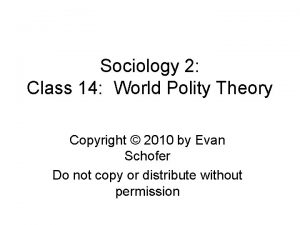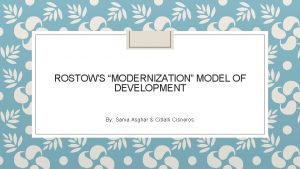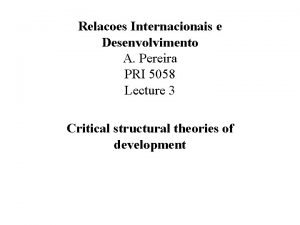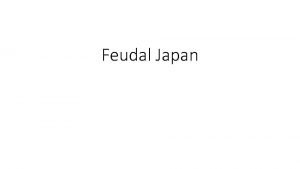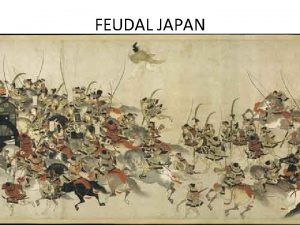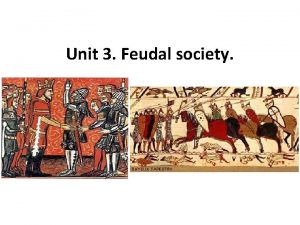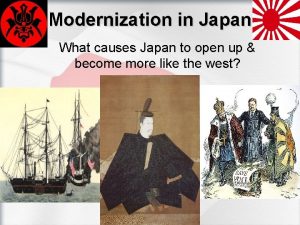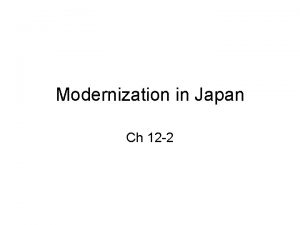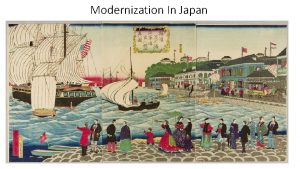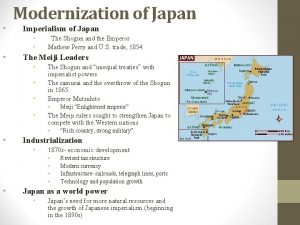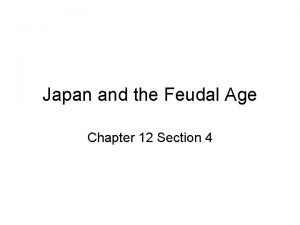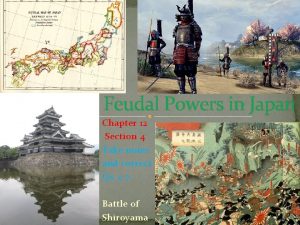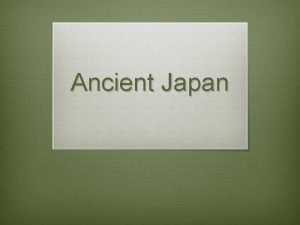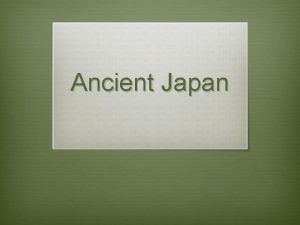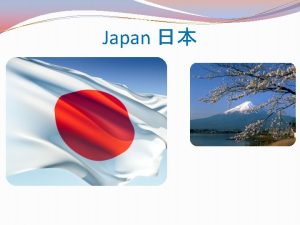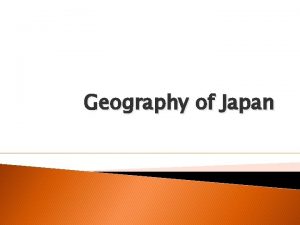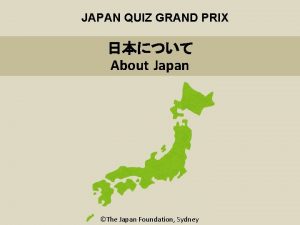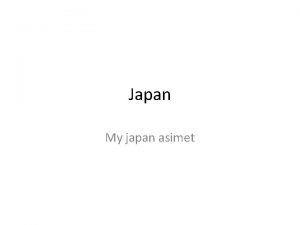Modernization of Japan Chapter 10 Sec 1 Feudal




























- Slides: 28

Modernization of Japan Chapter 10 Sec 1

Feudal Japan • Shoguns – – Military Dictators – Daimyos-land owning lords – Tokugawa family • Closed ports – isolationists (200 years)

Samurai Warrior Class in Japan, sworn to protect the Shogun and the Dayimo. Valued Pride and honor. However, often oppressed the civilians

Matthew Perry • Commodore Matthew Perry with orders from U. S. President Fillmore demanded Japan to open its ports – Japanese could not fight against modern weaponry – U. S. forced trading rights with Japan – Japanese were humiliated • Desire to modernization and militarism grew


Meiji Restoration • Discontent with the Shogun/ Samurai • Overthrew the Shogun • Emperor Matsushito was restored took the name Meiji • Emperor Meiji introduced western reforms – Western Traditions – Western government – Western Weaponry – Western Economics

Modernization • Centralized government modeled on western powers • Bureaucracy – Departments: Army, Navy, Education, etc • Diet – Legislature : Japanese Parliament • Technology • industrialization

Militarism/Nationalism/Aggression • First Sino Japanese War – Opened ports in China • Russo-Japanese war – Japan defeats Russia – First time a European power lost a war to a non. European country – Japan gains Korea and Manchuria • Annexation (incorporate/control) of Korea

From Victims to Aggressors!

The Last Samurai • Satsuma Rebellion – Samurai Revolt against Meiji Gov. – Samurai lost their status – Against westernization • Led by Saigo Takamori

Exit Card 1) What was the name of the U. S. Commodore that forced Japan to open its ports? 2) What was the Meiji Restoration? What happened to Japan as a result? 3) From what you learned today, why do you think Japan felt the need to modernize?

Saigō Takamori's statue near the southern entrance of Ueno Park

O. A. 2 1) Who do the characters in the Political Cartoon represent? 2) What is happening in the picture? 3) What is the meaning of the Political Cartoon? *Write down the questions*

Nationalism in China

Opium Wars


Fall of Qing (Last Imperial Dynasty) Empress Ci. Xi

“Twin Evils” of China • Warlords – Divided up the country • Foreign Imperialism – European powers drained the economy and political strength – Famine – Danger from Japan • 21 Demands – Japanese demands to China during WWI • After WWI, Allied powers gave Chinese territory to Japan

Nationalist Movements • May 4 th Movement (1919) – Student Protest against imperialism in china – Felt that Chinese government was too weak – Desired western reforms

Republic of China (R. O. C. ) • Angry students led Peasants joined the students in revolt. Several provinces declared themselves independent from the Qing. In 1911 Qing Dynasty was overthrown in 1911 • Revolutionary delegates in Nanjing created a provisional government and they named Sun Yat-sen, influential revolutionary, the very first president • President Sun Yat-sen proclaimed a new nation: the Republic of China’s first republic. • Was one of the founders of the nationalist party Goumindong • However, he did not have military power

Yuan Shi-Kai • Yuan Shi-kai was a general in the Qing dynasty • Allied with Goumindong (nationalist party) and Served as the President of provisional government • Once in power He dissolved Goumindong and the provisional gov. This led to the second revolution, where he defeated Sun Yatsen’s goumindong. • He ruled as a dictator until his death

Warlord Era

Nationalists (Goumindang) • After the death of Sun Yat-sen, Chiang Kai Shek, became the leader of the Guomindang • Guomindang attempted to centralized the gov – Established gov in south china, planned to raise an army to fight the warlords – Unlike Sun Yatsen, Chiang Kai Shek was not willing to work with the communists – Goumindang arrested and slaughtered communists – He gained support from the Western Nations in their battle against Communism (strong ties with U. S. )

Spread of Marxism • Marxism – Many turned to Marxist/Leninist ideas – Soviet Union welcomed Chinese students and military officials – Vanguards – Elite communist leaders and advocators – Communism promised land

Communists • Mao Zedong, a popular revolutionary leader of the Communists in China • He gained support from the Chinese urban workers and peasants • He and the communist gave land! • Soviet Union, provided assistance to help strengthen the Communists in China.

VS

Longmarch Retreat of the Red army from the Guomindang Red Army was polite to the peasants – made positive reputation Guomindang were cruel to the peasants Communists relocated up North

Common Enemy
 Chapter 28 section 2 modernization in japan
Chapter 28 section 2 modernization in japan Feudal japan
Feudal japan Modernization in japan
Modernization in japan Modernization in japan
Modernization in japan Feudal japan dbq
Feudal japan dbq Japanese feudalism social structure
Japanese feudalism social structure Feudal japan social structure
Feudal japan social structure Feudal japan hierarchy
Feudal japan hierarchy Feudal japan
Feudal japan Feudal japan pyramid
Feudal japan pyramid Feudal japan hierarchy
Feudal japan hierarchy Japan hierarchy system
Japan hierarchy system Feudal japan geography
Feudal japan geography Feudal japan
Feudal japan Tokugawa social structure
Tokugawa social structure Japan sec
Japan sec Modernization model ap human geography
Modernization model ap human geography Modernization theory vs dependency theory
Modernization theory vs dependency theory Classical modernization theory
Classical modernization theory Criticism of modernization theory
Criticism of modernization theory What are the 5 stages of rostow's model
What are the 5 stages of rostow's model Role of rrrlf in modernisation of libraries
Role of rrrlf in modernisation of libraries Modernization theory vs dependency theory
Modernization theory vs dependency theory Criticism of dependency theory
Criticism of dependency theory Idms modernization
Idms modernization Workplace modernization
Workplace modernization Compare and contrast the globalization and modernization
Compare and contrast the globalization and modernization Data modernization azure
Data modernization azure Wisconsin aprn modernization act
Wisconsin aprn modernization act
